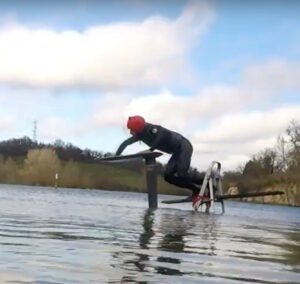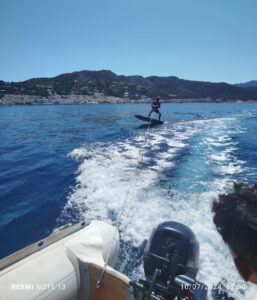The board is going to barely touch the water, so the smaller the better. It’s easier to handle when you’re moving it with your hands. Less room to put your foot incorrectly. Less travel for your feet to reach the centre in the initial jump. More visibility of the foil when you’re racing with it along the jetty.
The length:
The theoretical minimum size would be 80 cm long, unless you are taller than 1.85, then I think I would go for a minimum of 90 cm. But don’t worry if your board is a little longer, at the beginning it won’t matter.
As for the maximum, I think it would be 130 cm. I used a 128 cm board in several sessions when learning, and they told me it was too long, but I didn’t think so. Any longer, apart from giving it more unnecessary weight, it can start to touch the water too easily when pumping. That doesn’t mean it can’t be done, there are people who pump perfectly with SUP boards, but it’s not the best way to learn.
Width:
The minimum would be 34 centimeters wide (unless you have a foot larger than 45). I think the maximum would be 50 cm (I learned for a season with a 48 cm one and it didn’t go badly), but if you can do it with a narrower one, the better, so your feet will have to travel less from the pier to the center of the board.
Litres:
They are closely linked to the previous characteristics of length and width, so if you have chosen a small board it will only have a few litres, but without taking into account the space that more litres take up, it is an advantage for swimming back to the pier if you plan to do long runs.
Hardness (flexibility):
The less flexible the board is, the better. The pros use carbon boards for maximum rigidity and to fully optimize pumping, but for learning you hardly notice the difference (your pumping will be just as bad even if the board is carbon). In any case, among the options you have, go for the hardest. An epoxy surfboard is usually hard enough, but be careful with wakeboards which are sometimes more flexible, or if you make your board from a snowboard, skateboard or wood first try to see how flexible it is.And anyway, don’t get too obsessed with the hardness at first, unless it’s obvious that it bends easily, a beginner won’t notice the difference.
Other features:
The litres of the board don’t matter too much either, except for swimming back on the board when the more litres the better, but well at the beginning the distances will be very short so the less litres the less weight normally the better.
Shape doesn’t matter much as a beginner, just think that the less narrow the smaller and the flatter the better.. The weight obviously the less the better, but the same as always, as a beginner 1 kg more or less is not going to make much of a difference.
Types of boards:
- Inflatable board. They are generally not recommended for pump foil. They tend to be too big, so they are uncomfortable for the initial jump, you have to go a long way to get on them and they weigh more. They are also less rigid so the pumping is transmitted less well to the feet. An expert could do it, but it is not recommended for a beginner.
Yes, it is a narrow downwind style board, it is easier, but it is still not the best for beginners due to its weight and poorer balance.

- Handmade. You can take a piece of wood, cut it to size, make some holes for the foil and you’re ready to go. Just choose the least flexible one you can get. Try to use real wood not conglomerates which will be very flexible or otherwise too thick and heavy. Some people go out of their way to cover it with carbon to make it tougher, even putting in a box for the foil, but it’s a huge hassle and with the amount of money you have to invest in the material I don’t think it’s worth it unless you’re a handyman and enjoy doing it.
In my case I put some EVA foam on top of it, the kind they sell in Chinese stores, but it was too slippery to go barefoot and I used it with booties. Try using rough EVA foam, or after varnishing you can sprinkle beach sand on it before it dries and finish it off with surfboard wax, which will look better.
Make it as small as possible to reduce its weight, do not leave more than one centimeter behind the foil attachment, and for width and length, take the minimum recommendations that I gave at the beginning of the article.
In this video you can see how I pump with it without problems despite it being simple pine wood without any reinforcement.

- Foil surfboards. Paying attention to the size and getting a small one can be good for you, after all, foil surfers also pump to link one wave to the next, so obviously they can’t go wrong. But don’t think that you’re going to get much of a difference compared to the pine wood board, so I wouldn’t choose this option unless you have access to a cheap board or want to use it for foil surfing. After learning, I tried my first foil surfboard and the pine one again and I pumped much better with the pine one.

- Kiteboards. Kitefoil boards are usually small so it is possible to find an interesting one second hand. But not all kiteboards are the same, look for the smallest and lightest one possible. For example, I tried the gong kiwii 3.1 in the photo and it works great.
But I also tried the gong catch in this video (bigger, fatter, longer, wider) and it was quite difficult to pump.tefoil boards are usually small so it is possible to find some interesting ones second hand.

- Specific pumping boards. They have recently started to come out, in principle they are the ideal ones, hard (carbon lined), light and just the right size. They will be what you end up buying when you already know how to pump and want to optimize it to the maximum, but to start with a second-hand one of the previous types will also work for you. Some examples are:
What type of board to choose?
For the first sessions use whatever you have at hand, or can afford, even a simple wooden one will do at zero cost. But if you are in session 10 and you are still not able to correct the position of your feet when you are on the board, I would start looking at a board specialized for pumping, or a small kite board covered with EVA foam. With EVA foam and bare feet, correcting your feet is much easier, so this will save you from many incorrect initial jumps, making each session much more productive.



